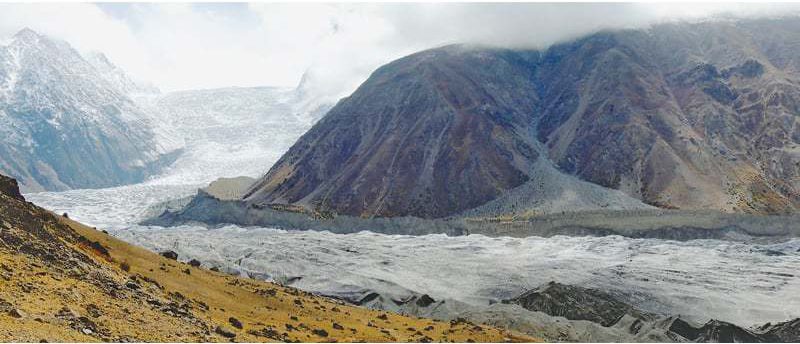HAMID AHMAD MIR

For the past three decades climatologists have been raising alarms about global warming and its consequences, and now geologists have also got involved in the issue. World’s renowned geologists are of the opinion that rapidly melting glaciers will result in increasing number of earthquakes, volcanic eruptions and tsunamis.
This is based on the premise that ice is extremely heavy — one cubic metre of ice weighs almost one ton and glacier being a colossal sheet of ice exerts tremendous pressure on the surface of the earth beneath their cover. When glaciers start to melt, as we are experiencing today, pressure on the earth’s surface on which the glaciers are located is reduced significantly. The lightening of load on the earth’s surface allows its mantle to rebound causing the tectonic plates beneath to become unstuck.
According to Patrick Wu, a geologist at the University of Alberta in Canada, the weight of thick ice puts a lot of pressure. This weight suppresses earthquakes, but when the ice melts earthquakes are triggered. Wu goes on to say that many earthquakes that occur in Canada today are related to this ongoing rebound effect that started with the end of the last Ice Age some 10,000 years ago.
The melting of glaciers can lead to more earthquakes in Pakistan and around the world
In the face of present global warming, rapidly changing climatic factors and speedy deglaciation the foreseeable rebound is expected to be much severe and faster. Experts term this rebound ‘Isostatic Rebound’. This process reactivates the fault, increases the seismic activity and lifts pressure on magma chambers that feed volcanoes.
Experts are also of the view that there are implications for parts of the world where glaciers and active faults coincide, including the Hindukush, Himalayas, Alps, Andes, etc. In Pakistan, in the Hindukush and Himalayan regions glacier melt due to climate change coincides with active faults.
Andrew Hynes, tectonics expert at McGill University, puts forward another theory to illustrate an additional relationship between glacier melt and earthquakes when he says that increased glacier melt increases the concentration of fluid in the fault that lubricates the rock, allowing the plates to slide.
An added phenomenon that needs to be kept in mind is that if glacier melt is reducing the stress on earth’s surface in glaciated areas, it is also increasing the stress on seafloors due to rapid influx of water.
The massive melting of ice might trigger earthquakes that are strong enough to lead to the seafloor collapsing or and underwater landslide that in turn could generate a tsunami. Melting of glaciers and the subsequent rise in sea level also means that previously exposed continental margins become inundated with water.
Melting of ice in Antarctica is already triggering earthquakes and underwater seafloor slides, says Wu. Although, at present, these events are not getting much attention, these are early warnings of the more serious events that scientists believe will be experienced in near future.
The glaciated areas in northern parts of Pakistan are quite vulnerable to such events as they are not only heavily glaciated but are also located on tectonic fault lines. For the last three decades the area is also experiencing rapid ice melt due to climate change. Climate change induced disasters, like Glacial Lake Outburst Floods (Glofs) and riverine floods, have become common features in the northern parts of the country. Call it a mere coincidence or reality that for the same period earthquake events are also showing an upward trend vis-a-vis the Glofs/floods.
The recent floods and earthquake events in Hindukush and Himalayan regions of Pakistan are clear evidences of this correlation. Over a period of three decades the frequency and intensity of both glacier-melt and occurrence of earthquakes in the northern regions of Pakistan have increased. Apparently both seem to be directly proportional to each other. During August 2013 alone, Chitral district and adjacent areas experienced over a dozen earthquakes of above five magnitude. During December 2015 and first week of January 2016, District Chitral and adjoining glaciated areas experienced over five devastating earthquakes.
In Chitral it has now become a common belief among the local communities that the frequency and devastation of earthquakes in winter is directly proportional to the severity and intensity of floods during the preceding summer. However, this myth of the local communities needs to be evaluated and studied in detail.
Chitral is home to some 542 glaciers with an estimated volume of nearly 269 cubic kilometres and alone counts for nine per cent of the total glacial or ice reserves of Pakistan. According to experts from the field of environment, glaciology and hydrology all glaciers of Pakistan will melt away completely by the year 2035.
As has been mentioned earlier, one cubic metre of glacial ice weighs almost one tonne. If by 2035 all glaciers in Pakistan melt away, as has been predicted by experts keeping in view the present melting rate, then it means removal of 269 billion tonnes of load from the surface of the earth’s crust in Chitral alone.
The melting of glaciers in the district is quite evident from increased number of Glofs and the ever increasing water flow in River Chitral (also known as River Kabul in the lower course) for the last two decades. However, the phenomenon needs to be studied in detail.
The writer is a field officer at the Pakistan Glof Project in Chitral
Published in Dawn, Sunday Magazine, July 31st, 2016
http://www.dawn.com/news/1274426

